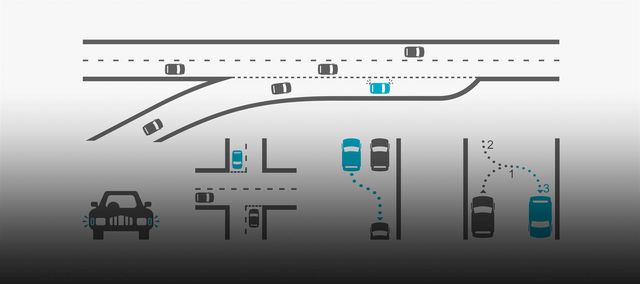31 January 2019
For many young people, especially those living in rural areas, getting a driving licence is the first big step to independence. And yet, not everyone always knows what they have to do, and when, to get that taste of automotive freedom and how best to prepare for the theoretical and practical tests. Our overview provides answers to the most important questions.
When can I start to learn to drive?
The standard minimum age for a normal driving licence is 18. For some time now, however, young people have been permitted to drive at 17 if accompanied by a full licence holder: In Germany, as long as a registered driver is sitting next to you, you can take the wheel at 17; as soon as you turn 18, you’re allowed to drive on your own like everyone else. Almost 50 percent of all learner drivers take the accompanied driving option. And that makes complete sense, says Wolfhardt Werner, director of driving competence at TÜV NORD. “Accompanied driving has proved a success in practice - both as a means of consolidating all the skills acquired in training and as a way of reducing accidents.” As well as parents, older siblings or training managers for apprenticeships are possible candidates to accompany learners. Generally speaking, it’s advisable to allow enough time to get a driving licence.
How do I find a good driving school?
In most cases, friends, acquaintances or family members have already had experience of different driving schools from which the aspiring learner can benefit. If you want to get an impression of driving schools and their instructors, it’s a good idea to visit them and, for instance, sign up for a trial driving lesson, says Wolfhardt Werner. As well as ease of access, the kind of car used by the school can also play a role. “If I set my sights on a particular car at home, and the driving school uses a similar model, that can influence my decision,” Werner says. In most cases, the driving school’s website will have all the information you need.
What are the additional requirements for getting a licence?
Anyone looking to apply for a driving licence needs to contact the responsible licence issuing authority with all the required documents. The driving schools usually apply on behalf of the learners. What you need for the application is an up-to-date biometric passport photo, a valid identity card or passport, a sight test certificate and confirmation that you have taken part in a first aid course. Driving schools can help you find such a course, but there are also plenty available online.
"The test syllabus is basically updated every six months, although individual questions can be adapted to changes in the law as and when required.”
How much time should I allow for the theory lessons?
If you’ve applied for a standard car licence, the law states that you need twelve double sessions to cover the basic syllabus and a further two for the additional content. The basic material covers issues that relate to all classes of driving licence, whereas the additional content relates specifically to the class of licence in question. The digital training programmes offered by the driving schools and other online products offer a wide range of practice options. Wolfhardt Werner’s advice is always to check that the content is up to date. "The test syllabus is basically updated every six months, although individual questions can be adapted to changes in the law as and when required,” the TÜV NORD expert explains. “Smaller educational publishers can sometimes get a bit behind. Large publishers revise their products twice a year and are always completely up to date.”
How does the driving instructor know that I'm ready for the theory test?
Previous generations used to fill out questionnaires in the driving school which were then marked by the driving instructor. These days it’s all done on computers. The instructor can make use of digital training systems to get a direct impression of how learners are getting on in their training at the school or on their home computers. It goes without saying, of course, that they shouldn’t seek the help of parents, siblings or knowledge from the Internet hive mind to answer the questions. “After all, you have to sit the exam on your own. This takes a lot of intensive study, which is then rewarded when the results come out,” says Wolfhardt Werner.
How does the theory test work?
Since 2010, all learners have been required to sit the theory test on a PC on the premises of the testing organisation in question. As in the training, the tasks are selected from a pool of about 1,000 questions that have been published in the official catalogue of questions issued by the German Ministry of Transport and Digital Infrastructure. In the theory test for standard car licences, the learner has to answer 30 questions, 20 of which are drawn from the basic syllabus and 10 from the additional material.
Why have the practice and the test now been digitalised?
The old paper exams always showed the same images along with the respective questions and their possible answers in a fixed order. This promoted schematic learning through recognition. Using digital technology, however, it’s now easy to vary both the sequence of possible answers and the images associated with them, including everything from vehicle colour and the season being depicted through to the road environment. “This means that learners now always need to look at and understand a specific traffic situation to be able to answer the question,” Wolfhardt Werner explains. And to ensure that the theoretical training approximates as closely as possible to real traffic conditions, video questions are also now used. In short 3-D animations, the learner sees the traffic situation from the driver’s perspective, including rear-view and wing mirrors and the speedometer. Once they have watched the video up to five times, they are asked the related question. “This takes a little getting used to but is of course a lot closer to reality than just rote learning for specific questions,” Werner says.
Can I take the test in another language?
The theory test is now offered in twelve other languages alongside German. English, French, Russian, Turkish and Spanish were joined two years ago by Arabic. The languages permitted in the test are in principle decided by the legislature. The testing organisations, which in Germany include TÜV and DEKRA, then ensure that all the questions from the pool are available in the corresponding translation.
Can I take the practical test in another language too or, if need be, hire an interpreter?
The practical test can be taken only in German and without an interpreter. This is for legal as well as practical reasons: an interpreter might secretly and illegally provide the learner with assistance. It also goes without saying that no examiner will master 13 languages. “And to speak to one candidate in English without being able to address another in Arabic would amount to an indefensible bias,” Werner explains. In any case, the practical test requires less of a grasp of the language than the theoretical part. “To follow the examiner’s instructions, you do of course need a certain basic level vocabulary, but this is way less than what is needed to answer the complex questions asked in the theory test,” Wolfhardt Werner adds. Since the summer of 2018, a list of the minimum vocabulary required for the practical test has been offering guidance for everyone involved: It acquaints the instructors with the German expressions their students should have mastered by the time they come to take the test; in turn, the examiners know which words they can use with someone who doesn’t speak much German.
And what if my ability to read or hear is impaired?
If you’re dyslexic, for instance, you can arrange for the questions to be read out by an audio support program. Deaf people can use a sign language interpreter for the theoretical and practical tests. “If you want to use this option, you have to tell the licence issuing authority when you submit your application so that the testing organisation can book the interpreter for the test,” Wolfhardt Werner explains.
How many mistakes can I make before I fail?
To pass the theory test you are allowed a maximum of ten mistakes. The simplest questions are worth two points; difficult questions, for instance about rights of way, are worth five. If you get the answers to two five-point questions wrong, you will fail the test. You will then get a summary of the results including the subject areas in which you got the answers wrong. “This tells you what you need to improve to pass the test at the second attempt,” Wolfhardt Werner says. The retest is usually possible after 14 days.
Can I resit a test as often as I want?
Although learners used to be threatened with a waiting period of three months after the third failed test, there’s now no limit to how often you can take either the theoretical or the practical test. You do however have to pay the exam fee all over again each time. But Wolfhardt Werner’s advice is that you shouldn’t rely on luck or take a test after half-hearted preparation. “As far as I’m concerned, that’s the wrong way to go about passing your test.”
How many hours of lessons should I reckon with as a minimum?
Special training sessions on the motorway, on country roads and in the dark are all mandatory. But no learner is allowed to do them before they have acquired the basic skills. And, these days, this varies widely from candidate to candidate, Wolfhardt Werner says. “A lot of learner drivers don’t have even the basic skills they need to negotiate normal traffic situations. This is what the driving schools are always telling us.” The expert lays the blame at the door of parents who always drive their offspring around. “It’s extremely important for learners to have an early experience of responsible road use. And they’ll never have that experience, of course, if they’re always driven to school,” Werner states. The expert’s recommendation is not to speculate about some minimum number of lessons but instead to err on the safe side by having more than you need.
“It’s extremely important for learners to have an early experience of responsible road use.“
How will the driving instructor know that I'm ready for the practical test?
The aim of driving lessons is to enable the learner to master ever more complex traffic situations independently and safely. A good indication is often to observe where the learner’s attention is going. “If the learner’s attention is focused completely on the traffic rather than the controls in the car, then that’s a good sign,” Wolfhardt Werner explains.
My training vehicle has a lane-tracking system. Can I use this in the test?
You can indeed use assistance systems in the test. “But, as a learner, you need to be able to use them sensibly in accordance with the situation and to operate them yourself,” Wolfhardt Werner says. For instance, you need to be able to intervene at any time if your cruise control is set too high for you to exit the motorway safely.
How does the practical test work exactly?
The test takes 45 minutes in total, 35 minutes of which are actually spent driving. Once the examiner has greeted the candidate and verified their identity, the latter has to go through the safety checks. “The candidate has to complete two or three tasks to demonstrate how they would assure themselves that the car is safe to drive,” Werner explains. During the test drive, which includes routes in and outside of built-up areas, the examiner tells the candidate to perform some basic driving tasks: For example, the candidate will have to carry out a three-point turn or parallel park.
Can the examiner use gut instinct to decide on the route, which elements to test and how to evaluate them?
The legal underpinning of the entire process is the German Driving Licence Regulation This defines the framework conditions under which a licence may be granted and kept. The examiners rely on a specific testing directive. This defines, for instance, how many questions from which topic areas the theory part must contain and the requirements a test route needs to satisfy if it is to be used for a driving test. “The testing directive also describes how mistakes should be evaluated and when a candidate should be deemed to have failed,” Werner explains. In any case, committing any of the ten deadly sins - such as driving through a red light or a stop sign or putting another road user in danger - is an automatic fail. Less serious mistakes, such as driving too close to the car in front, can likewise result in failure. But they don’t necessarily have to: the testing directive allows the examiner to take a particularly good performance into account in the overall assessment. “If someone has performed above average in carrying out their driving tasks, a few minor mistakes won’t cause them to fail,” Werner explains.
What happens if I don't pass?
As in the theory test, the examiner will initially give the candidate their result and tell them where the key mistakes were made; these will also be documented and given to the candidate for future reference. The unsuccessful candidate can then prepare for the retest with their instructor; this can generally take place after 14 days. "The task of the driving instructor is then to thoroughly go into the critical driving situation with the learner and to instil enough confidence in them to allow them to go into the next test with a positive attitude,” Wolfhardt Werner says.
And if I pass?
Assuming you’ve reached the statutory minimum age, you will then receive your licence or certification of accompanied driving directly from the examiner. “In officialese, it says: ‘Permission to drive is granted with the actual issue of the driving licence,” TÜV NORD expert Werner adds. Translated into everyday language, this means that you can get behind the wheel on your own right away.
ABOUT
© TÜV NORD
Wolf Werner is a graduate mechanical engineer in vehicle technology, an officially recognised examiner and a director of driving competence at TÜV NORD Mobilität.
Optimised practical driving test
The process for obtaining a driving licence is continuously being improved for both theoretical and practical elements. The next great innovation is the imminent optimised practical driving test. This is intended to convey to the applicant a fuller picture of their driving skills even after they have passed the test and also to point out potential for further improvement. For this purpose, a comprehensive catalogue of driving tasks was created over a period of about ten years. It contains all the situations that can arise in road traffic, including the assessment criteria to be applied in each case. The new system has already successfully been applied in practice in some 10,000 tests. The regulation is expected to be adopted at the beginning of this year and will come into effect in 2021.




